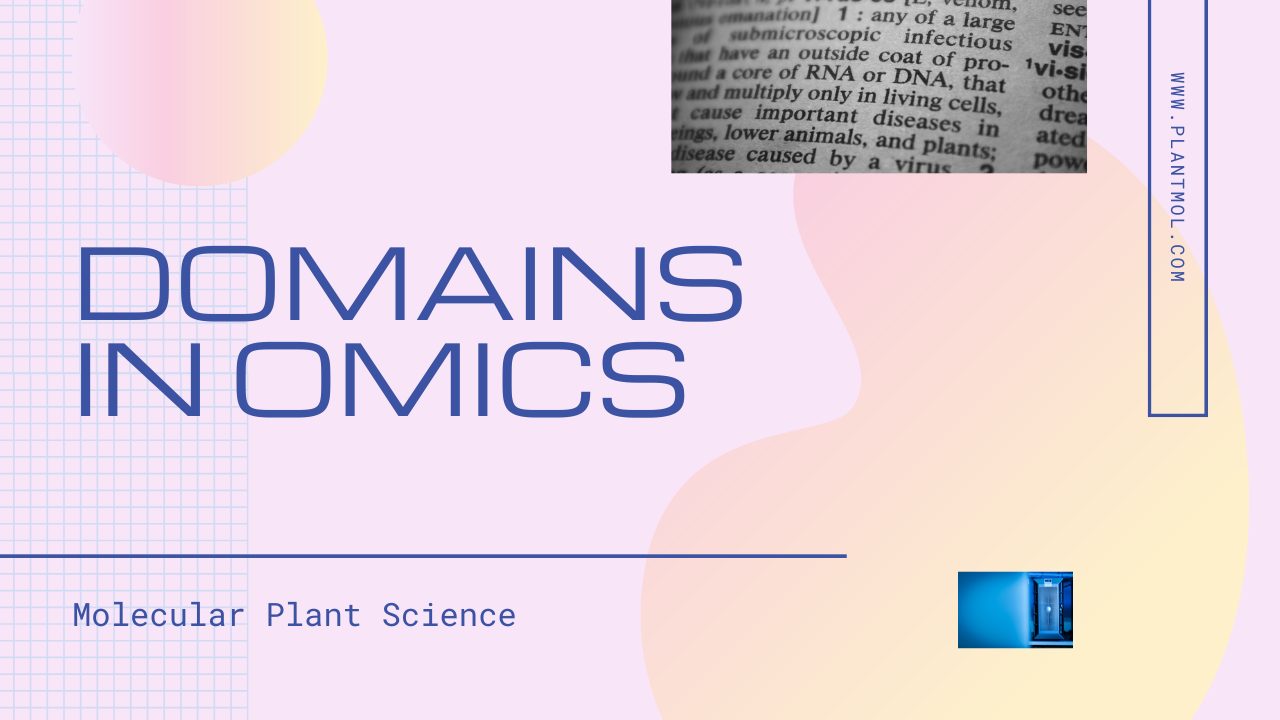In the expanding field of omics, which encompasses genomics, proteomics, transcriptomics, and metabolomics, the study of domains is essential for understanding how biological molecules function and interact. Domains are distinct structural or functional units within a protein, gene, or other biomolecule, acting as the “modules” that confer specific abilities, such as binding to other molecules, catalyzing chemical reactions, or regulating gene expression.
The discovery and characterization of domains across various omics layers have propelled advances in fields like evolutionary biology, drug development, and synthetic biology. From zinc-finger domains that facilitate DNA binding to kinase domains that drive cellular signaling, domains provide deep insights into the molecular mechanisms underlying life processes. They also offer opportunities for targeted therapeutic interventions, crop improvement, and the study of evolutionary conservation.
Here, we explore the concept of domains, current research trends, and cutting-edge methodologies used for domain discovery and analysis in omics.
What Are Domains?
Domains are the functional and structural subunits of biomolecules, often found in proteins and DNA/RNA sequences. In proteins, domains are typically compact, stable regions that fold independently and often have specific biological functions. In genomics, a domain may refer to specific sequences of DNA that have a particular regulatory or coding role.
For example:
- Protein Domains: Such as SH2 domains, which mediate protein-protein interactions, or catalytic domains found in enzymes.
- DNA Domains: These are regions that regulate chromatin structure, such as enhancer domains or topologically associating domains (TADs).
- RNA Domains: Important for the formation of secondary structures that influence RNA stability and translation, like the IRES domain in viral genomes.
Fascinating Facts About Domains
- Evolutionary Legos: Domains can be shuffled around during evolution, a process called domain shuffling. This has enabled the creation of proteins with new functions by combining pre-existing domains in different ways. For example, human kinases share common domains with kinases from yeast, showcasing deep evolutionary conservation.
- Zinc Finger Revolution: The discovery of zinc finger domains in proteins opened up a whole new era of genome editing. Zinc finger nucleases (ZFNs) were one of the first tools used for targeted genome editing, a precursor to CRISPR-Cas9.
- Multiple Domains, One Protein: Many proteins consist of multiple domains, each with a specific function. For instance, transcription factors often have separate DNA-binding domains and activation domains, allowing them to perform more complex regulatory functions.
- Cross-Kingdom Domains: Certain domains are conserved across different biological kingdoms (e.g., plants, animals, and fungi). Domains like the WD40 domain are involved in various cellular processes, from signal transduction to vesicular trafficking, indicating their widespread functional importance across species.
Current Research Trends in Domain Study Across Omics
1. Evolution of Domain Architectures
Research into how domain architectures (the arrangement of domains within a protein or gene) have evolved is shedding light on the origins of functional diversity in proteins. By analyzing how domains are combined and reorganized through domain shuffling, researchers can infer evolutionary relationships and understand the evolution of complex proteins.
- Example: Comparative genomics studies have shown that the evolution of novel domain architectures is a key driver of the diversification of regulatory proteins in plants. For example, WRKY transcription factors, which play a crucial role in plant immunity, exhibit different domain architectures that influence their regulatory functions across species.
2. Domains in Protein-Protein Interactions
Protein domains are central to understanding protein-protein interactions (PPIs). Domains like SH3, PDZ, and kinase domains mediate specific interactions, enabling precise communication between proteins in signaling pathways. Research is now focusing on mapping the domain interactions that regulate cellular processes, using techniques like co-immunoprecipitation and mass spectrometry to detect protein complexes.
- Example: Proteomic studies are using mass spectrometry-based interactomics to identify the domain-domain interactions involved in critical pathways like apoptosis or immune signaling. This data can then be integrated with domain databases to predict new interactions in disease contexts.
3. Domains in Epigenetics and Chromatin Organization
In the context of epigenomics, domains like bromodomains, which recognize acetylated lysines, or chromodomains, which bind methylated histones, are pivotal in regulating chromatin dynamics and gene expression. Understanding these domain-mediated interactions is key to decoding how epigenetic modifications influence gene regulation and cellular differentiation.
- Example: Researchers are investigating the role of domains like SET domains, involved in histone methylation, in controlling gene expression during development and differentiation in both plants and animals.
4. High-Throughput Domain Discovery Using Machine Learning
Advances in machine learning (ML) and artificial intelligence (AI) are enabling researchers to discover novel domains in large datasets generated by high-throughput sequencing and proteomics. By training models to recognize patterns in protein sequences and structural data, researchers can identify previously uncharacterized domains that may have important biological functions.
- Example: Tools like DeepMind’s AlphaFold are utilizing AI to predict protein structures with unprecedented accuracy, leading to the discovery of new functional domains within proteins that were previously not well understood.
5. Domain Engineering in Synthetic Biology
In synthetic biology, domains are being engineered to create proteins with novel functions. By assembling proteins with custom domain architectures, researchers are developing new enzymes, regulatory proteins, and signaling molecules with applications in biotechnology and medicine. For instance, fusion proteins created by combining catalytic and binding domains from different proteins can perform complex tasks such as targeted drug delivery or biosensing.
- Example: Engineering new synthetic zinc finger domains to target specific DNA sequences has led to advancements in gene therapy, where researchers can precisely control gene expression in therapeutic applications.
6. Proteomic Techniques for Domain Identification
Proteomics, especially mass spectrometry (MS), is widely used to identify protein domains and their post-translational modifications (PTMs). Techniques such as shotgun proteomics allow for the analysis of domain modifications and interactions under different biological conditions, providing insights into how domains regulate protein function.
- Example: A study utilizing MS to investigate the domains of polyamine biosynthesis enzymes revealed specific post-translational modifications (like phosphorylation) that regulate enzyme activity in response to environmental stress.
7. Structural Genomics and Domain Mapping
Structural genomics aims to determine the 3D structure of every protein encoded by a given genome. By mapping domain structures, researchers can better understand how protein function is related to structure and how mutations in domain regions may cause disease. This has applications in drug design, where identifying active sites in domains can lead to the development of targeted therapies.
- Example: The use of X-ray crystallography and NMR spectroscopy in structural genomics is helping to solve the structures of domains involved in cancer, such as oncogenic kinase domains, which are targets for many cancer drugs.
Methods and Tools for Domain Analysis
1. Pfam Database
Pfam is one of the most comprehensive resources for identifying protein domains and families. It includes a large collection of protein domain alignments and hidden Markov models (HMMs) to classify domains based on sequence homology.
- Website: Pfam Database
2. InterPro
InterPro integrates information from multiple domain databases, providing functional analysis of protein sequences by classifying them into families and predicting the presence of domains and important sites.
- Website: InterPro
3. SMART (Simple Modular Architecture Research Tool)
SMART allows the identification and analysis of domain architectures in proteins. It focuses on signaling and extracellular domains and provides detailed annotation of domain features.
- Website: SMART
4. CDD (Conserved Domain Database)
The CDD provides information about conserved domains, including sequence alignments and structure-function annotations. It is particularly useful for studying evolutionary relationships and functional prediction.
- Website: CDD Database
5. PROSITE
PROSITE is a database of protein domains, families, and functional sites. It contains patterns and profiles that allow the identification of known domains and motifs in protein sequences.
- Website: PROSITE
Conclusion
Domains are the building blocks that shape the functionality of biological macromolecules, playing crucial roles in everything from gene regulation to protein interactions. The study of domains in omics continues to evolve with advances in computational biology, AI, and structural genomics, providing unprecedented insights into how life functions at a molecular level. Whether through AI-driven domain discovery, proteomic analysis, or synthetic biology applications, the future of domain research promises to unlock new possibilities in medicine, agriculture, and biotechnology.
References
- Sadiq, S., Hussain, M., Iqbal, S., Shafiq, M., Balal, R. M., Seleiman, M. F., Chater, J., & Shahid, M. A. (2023). Genome-Wide Identification and Characterization of the Biosynthesis of the Polyamine Gene Family in Citrus unshiu. Genes, 14(8). https://doi.org/10.3390/genes14081527
- Sami, A., Haider, M. Z., Shafiq, M., Sadiq, S., & Ahmad, F. (2023). Genome-Wide Identification and In-silico Expression Analysis of CCO Gene Family in Sunflower (Helianthus annnus). https://doi.org/10.1007/s11103-024-01433-0
- Ali, M., Shafiq, M., Haider, M. Z., Sami, A., Alam, P., Albalawi, T., Kamran, Z., Sadiq, S., Hussain, M., Shahid, M. A., Jeridi, M., Ashraf, G. A., Manzoor, M. A., & Sabir, I. A. (2024). Genome-wide analysis of NPR1-like genes in citrus species and expression analysis in response to citrus canker (Xanthomonas axonopodis pv. citri). Frontiers in Plant Science, 15. https://doi.org/10.3389/fpls.2024.1333286
- Finn, R.D., et al. (2014). Pfam: the protein families database. Nucleic Acids Research, 42(D1): D222-D230. https://pfam.xfam.org
- El-Gebali, S., et al. (2019). The InterPro protein families and domains database: 20 years on. Nucleic Acids Research, 47(D1): D1105-D1115. https://www.ebi.ac.uk/interpro/
- Schultz, J., et al. (1998). SMART: a web-based tool for the study of genetically mobile domains. Nucleic Acids Research, 26(1): 224-228. http://smart.embl-heidelberg.de
- Marchler-Bauer, A., et al. (2017). CDD: a conserved domain database for the functional annotation of proteins. Nucleic Acids Research, 45(D1): D215-D219. https://www.ncbi.nlm.nih.gov/Structure/cdd/cdd.shtml
- Sigrist, C.J.A., et al. (2013). PROSITE: a protein domain database for functional characterization and annotation. Nucleic Acids Research, 41(D1): D344-D347. https://prosite.expasy.org
- Dobin, A., et al. (2013). Deep learning for motif prediction in genomics. Bioinformatics, 29: 15-24.
- DeepMind. (2020). AlphaFold: AI system for protein folding prediction.
Step 3 Motif and Domain Analysis in Genome-Wide Analysis of Gene Families








Motif And Domain Analysis Of Protein In Genome Ide Analysis
[…] Domain analysis plays a pivotal role in the study of gene families by focusing on the distinct functional and structural units within proteins known as protein domains. A protein domain is a conserved part of a protein’s sequence that can evolve, function, and exist independently of the rest of the protein. This structural characteristic allows protein domains to facilitate the diverse array of biochemical functions necessary for biological processes. Thus, the identification and characterization of these domains are paramount in understanding the complexities of gene families. […]
Saleha Sadiq
Thank you for sharing this insightful overview of motif and domain analysis in protein studies! It’s compelling how protein domains serve as fundamental building blocks that enhance our understanding of gene families and their diverse functions. Your discussion on the evolutionary significance and independence of these domains really underscores their critical role in biological processes. I look forward to seeing more research in this fascinating field!
Davidecola
Макс Мара — легендарный итальянский бренд, известный на производстве элегантной одежды премиум-класса. Основанный в начале 50-х, он превратился в эталон безупречного стиля и качественного пошива. http://liecebnarieka.sk/forums/topic/blazerifdkf449-4/#post-3161113 Знаковые пальто бренда покорили сердца ценителей моды по всему миру.
Albertoteede
Burberry — это знаменитый британский бренд, символизирующий стиль и безупречность. Основанный в 1856 году, он завоевал признание благодаря уникальному дизайну и плащам. https://eriac.org/the-golden-thread-an-introduction-to-the-publication-the-other-side-of-the-image/#comment-13540 Сегодня Burberry — это целая индустрия, предлагающая уникальные коллекции и задающая мировые тенденции. Бренд гармонично интегрирует традиции и новаторские идеи, создавая стильные образы.